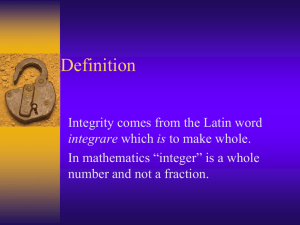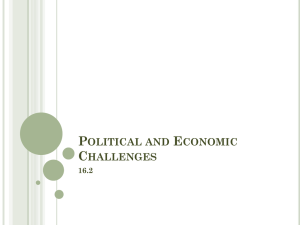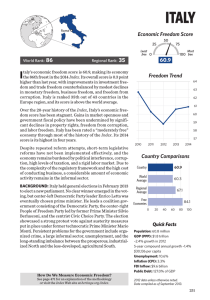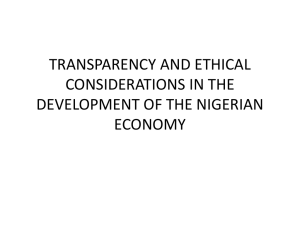Wanakiti_Economic Consequences of Corruption
advertisement
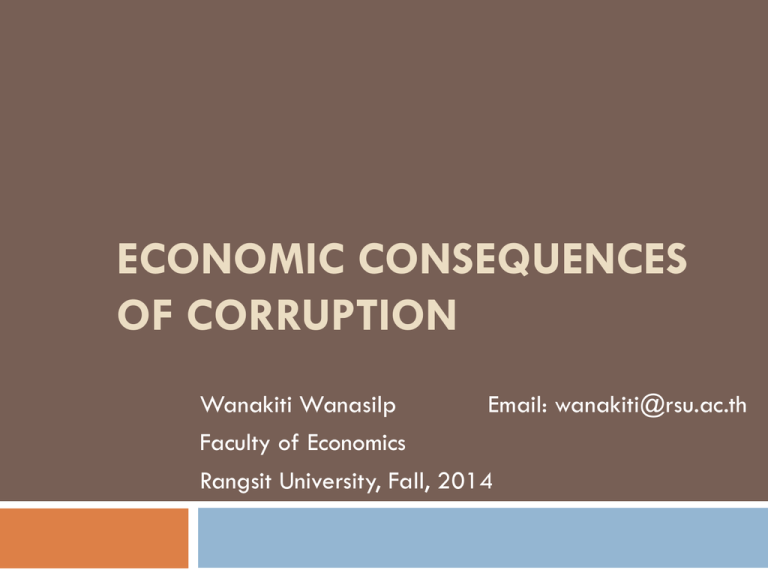
ECONOMIC CONSEQUENCES OF CORRUPTION Wanakiti Wanasilp Email: wanakiti@rsu.ac.th Faculty of Economics Rangsit University, Fall, 2014 CORRUPTION AND MARKET FAILURES MARKET FAILURES CORRUPTION -MONOPOLY -EXTERNALITIES -PUBLIC GOODS -IMPERFECT INFORMATION INEFFICIENT RESOURCE ALLOCATION - Figure 1: Conceptual Framework; Effects of Corruption on Resource Allocation CORRUPTION AND EFFICIENCY LOSS In this paper, we claim that the damages in term of economic efficiency loss caused by corruption is much larger and more severe than monetary loss generally focused in related literature. Economic efficiency loss means the loss incurred when the economy is unable to perform at its potentiality due to market failures that are in large part caused by corruptions. EFFICIENCY OF ECONOMIC SYSTEM In modern (capitalist) economic theory, it is postulated that the economic system will perform at its best (efficient) when it is run by private sector, with minimal intervention by the government. The incentives that drive private sector to work include those concerned with self-interest (profit maximization, private ownership, wealth accumulation, etc.). Free competition, supported by democratic political system, will be the rule of the game. MARKET FAILURES Unfortunately, while the system driven predominantly by private sector is operating onward, it will encounter the situations called “Market Failures”, which is sure to occur (unavoidable) under capitalist system. Examples of these market failures are: monopoly, public goods, externalities, imperfect information, moral deficiency, etc. MARKET FAILURES When these market failures occur, the economic system will perform at lower than its potential (i.e., at sub-optimal level), incurring efficiency loss. When the market failures occur, it will become legitimate for the government to intervene in order to correct market failures. CORRUPTION AND MARKET FAILURES However, if the government is corrupt, then an attempt to correct market failures will be fruitless. As a matter of fact, it is the corruption itself that aggravate the conditions of market failures. The evidence to support the above claim is obvious. Countries with high level of corruption will have high level of monopoly (in business, information and politics), vast destruction of environment, low level (and low quality) of public services, etc. Consequently, these countries cannot develop the economy to advanced level. CORRUPTION AND EFFICIENCY LOSS Let’s take a look at the Corruption Perception Index (CPI) constructed by Transparency International (TI), an institution devoted to fighting corruption around the world. From tables below, it can be seen that countries with successful economic development are associated with low corruption (high CPI score), while countries with slow economic progress are associated with high corruption (low CPI score). Table 1: Top twenty countries with high CPI score (i.e., low corruption) Rank Country 1 3 3 5 5 7 8 9 9 11 12 12 14 15 15 15 18 19 19 New Zealand Finland Sweden Norway Singapore Switzerland Netherland Australia Canada Luxembourg Germany Iceland United Kingdom Barbados Belgium Hong Kong Japan United States Uruguay CPI Score 91 89 89 86 86 85 83 81 81 80 78 78 76 75 75 75 74 73 73 GDP per capita (US$ per year) 36,900 46,490 56,120 98,790 47,210 80,970 48,000 59,260 51,570 71,640 45,070 38,270 38,500 15,080 44,720 36,560 47,870 52,340 13,580 GDP growth (%) 3.2 -0.8 0.9 2.9 1.3 1.0 -1.2 3.4 1.7 -0.2 0.7 1.4 0.3 0.0 -0.1 1.5 2.0 2.8 3.9 Table 2: Bottom twenty countries with low CPI score (high corruption) Rank Country 150 150 150 153 154 154 157 157 160 160 160 163 163 163 167 168 171 172 174 175 Kyrgyztan Guinea Paraguay Angola Congo Republic Tajikistan Burundi Zimbabwe Cambodia Eritrea Venezuela Chad Guinea- Bissau Haiti Yemen Turkmenistan Iraq Libya Sudan Afghanistan CPI)* score 24 24 24 23 22 22 21 21 20 20 20 19 19 19 18 17 16 15 11 8 GDP per capita** (US$ per year) 990 440 3,400 4,580 2,550 880 240 650 880 450 12,460 770 510 760 1,270 5,410 6,130 12,930 1,500 680 GDP growth ** (%) -0.9 3.9 -1.2 6.8 3.8 7.5 4.0 4.4 7.3 7.0 5.6 8.9 -6.7 2.8 0.1 11.1 9.3 2.1 -10.1 14.4 Table 3: Comparison among ASEAN countries. Rank Country 5 38 53 94 102 114 116 140 157 160 Singapore Brunei Malaysia Philippines Thailand Indonesia Vietnam Laos Myanmar Cambodia CPI)* score 86 60 50 36 35 32 31 26 21 20 GDP per capita** (current US$) 47,210 31,590 9,820 2,500 5,210 3,420 1,550 1,270 NA 880 GDP growth ** (%) 1.3 2.2 5.6 6.8 6.5 6.2 5.2 8.2 NA 7.3 THANK YOU.

